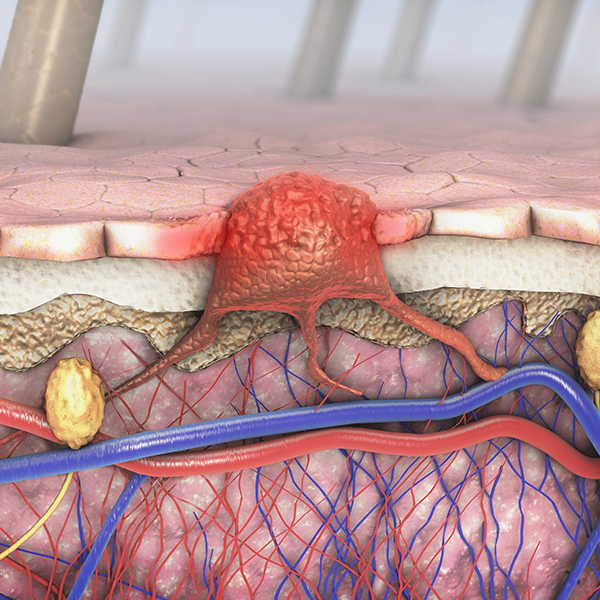-
Protective Mastectomies that Preserve Nipple Safe for Women at High Breast Cancer Risk
 DALLAS — Protective mastectomies that preserve the nipple and surrounding skin prevent breast cancer as effectively as more invasive surgeries for women with a genetic mutation called BRCA that raises their risk of developing breast cancer, a multi-institution study led by Mayo Clinic found. The research should reassure patients and surgeons that nipple-sparing mastectomies, which leave women with more natural-looking breasts than other mastectomies, are a safe way to reduce breast cancer risk in BRCA carriers, the authors say. The findings were presented at the annual meeting of the American Society of Breast Surgeons in Dallas.
DALLAS — Protective mastectomies that preserve the nipple and surrounding skin prevent breast cancer as effectively as more invasive surgeries for women with a genetic mutation called BRCA that raises their risk of developing breast cancer, a multi-institution study led by Mayo Clinic found. The research should reassure patients and surgeons that nipple-sparing mastectomies, which leave women with more natural-looking breasts than other mastectomies, are a safe way to reduce breast cancer risk in BRCA carriers, the authors say. The findings were presented at the annual meeting of the American Society of Breast Surgeons in Dallas.
“Nipple-sparing mastectomy is gaining wide acceptance because of its superior cosmetic results, but pockets of the medical community remain skeptical that it is the right choice for the BRCA population,” says study lead author James Jakub, M.D., a breast surgeon at Mayo Clinic in Rochester, Minnesota. “This is the largest study of its kind to address the controversy, and to show that nipple-sparing mastectomy is as effective at preventing breast cancer as traditional mastectomy.”
To determine the incidence of breast cancer in BCRA-positive women who had prophylactic nipple-sparing mastectomies, researchers studied outcomes among 348 patients who collectively had 551 mastectomies performed at nine institutions between 1968 and 2013.
The study included 203 women who had both breasts removed protectively, known as a bilateral mastectomy, and 145 patients who had one breast removed preventively after cancer occurred in the other breast.
None of the patients who had a bilateral nipple-sparing mastectomy developed breast cancer at any site after an average of three to five years of follow-up, the researchers found. No breast cancers developed in the retained skin, nipples, or lymph nodes on the side of the prophylactic procedure. Seven women died from breast cancer during follow-up; in all of those cases the patients had a previous or concurrent breast cancer at the time of surgery and their stage IV disease was attributed to that cancer.
MEDIA CONTACT: Sharon Theimer, Mayo Clinic Public Affairs, 507-284-5005, newsbureau@mayo.edu
Mastectomies have changed dramatically over the years. The radical mastectomy of the 1950s, 60s, and 70s removed the breast tissue, skin, lymph nodes, and underlying muscle. By the 1980s, that procedure largely gave way to the modified radical mastectomy, which left the chest muscles alone. Next came skin-sparing mastectomies, which preserve an envelope of skin and allow surgeons to begin breast reconstruction during the mastectomy surgery.
Nipple-sparing mastectomies leave the nipple, areola and breast skin intact. Their use is increasing and has gained acceptance as a safe option in breast cancer patients.
In 2009, approximately 8 percent of mastectomies performed at Mayo Clinic were nipple-sparing. Five years later, that fraction had more than tripled to approximately 30 percent, and Dr. Jakub says the number is increasing. Still, controversy remains over whether or not the procedure is appropriate for women with BRCA mutations, who can have a breast cancer risk of 50 to 60 percent by age 70 and up to 80 percent over a lifetime.
“The BRCA population has a genetic mutation in all the cells of their body that predisposes them to breast cancer,” Dr. Jakub says. “We know that a majority of breast cancers originate in the breast ducts, so it might seem counterintuitive to leave behind the nipple and the ducts associated with the nipple when you are trying to reduce the risk of this disease.”
Several studies have shown the procedure is safe among BCRA carriers, but some physicians have been waiting for more evidence, Dr. Jakub says. He believes the study results offer further proof that nipple-sparing mastectomies are effective in preventing breast cancer among women carrying the BRCA mutation and should be offered when they consider prophylactic surgery.
https://youtu.be/h-VNMkMMHp4
“There is no question that this option of nipple-sparing mastectomy can often provide an outstanding cosmetic result and may make it easier for women who are at risk to take this preventive measure,” Dr. Jakub says. “Though the nipple is preserved, it unfortunately will not have stimulation or arousal. Despite that, studies looking at the impact of risk-reducing surgery on quality of life, sexual satisfaction, and intimacy, suggest that being able to preserve aesthetics and body image can improve all of these factors.”
The study’s senior author is Shawna Willey, M.D., of Georgetown University. The co-authors are Richard Gray, M.D., and Sarah McLaughlin, M.D., of Mayo Clinic; Anne Peled, M.D., of the University of California San Francisco; Rachel Greenup, M.D., of Duke University; John Kiluk, M.D., of Moffitt Cancer Center; Virgilio Sacchini, M.D., of Memorial Sloan Kettering; and Julia Tchou, M.D., Ph.D., of the University of Pennsylvania.
The study was supported by National Institutes of Health Specialized Program of Research Excellence in Breast Cancer grant CA116201 and the Breast Cancer Research Foundation.
About Mayo Clinic Cancer Center
As a leading institution funded by the National Cancer Institute, Mayo Clinic Cancer Center conducts basic, clinical and population science research, translating discoveries into improved methods for prevention, diagnosis, prognosis and therapy. For information on cancer clinical trials, call 1-855-776-0015 (toll-free).
###
About Mayo Clinic
Mayo Clinic is a nonprofit organization committed to medical research and education, and providing expert, whole-person care to everyone who needs healing. For more information, visit http://www.mayoclinic.org/about-mayo-clinic or https://newsnetwork.mayoclinic.org/.







